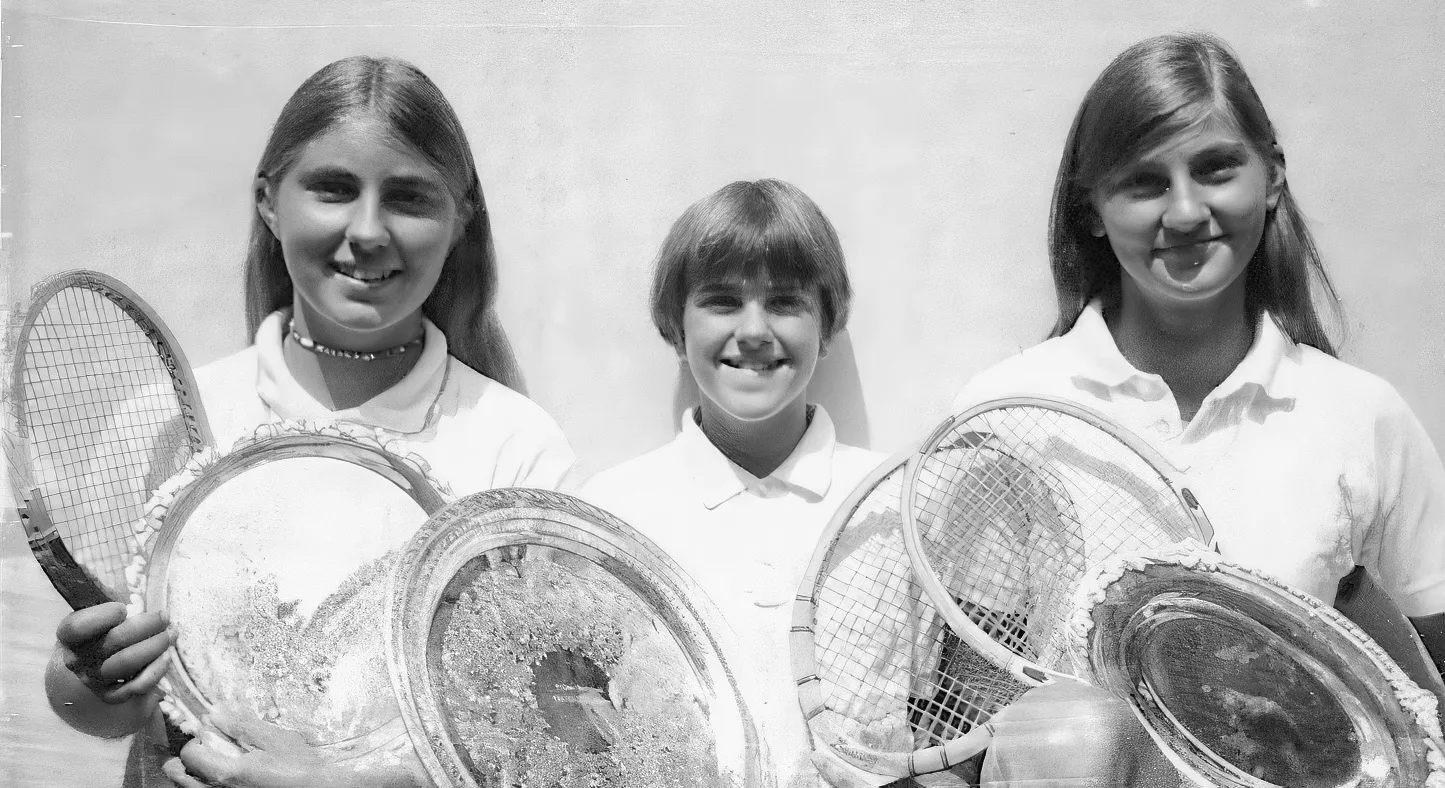Story by Ron Cobb
Special to the St. Louis Tennis Hall of Fame
In anticipation of the 2024 opening of the new St. Louis Tennis Hall of Fame at the Armory, 2016 inductee Ron Cobb has written a “What’s Up With” feature on every living Hall of Fame member. Ongoing, he is also writing regular features about the Hall of Fame and the Armory. And you can expect stories and other media about all our inductees, living and in memoriam.
Kim Steinmetz played professional tennis for 10 years, broke into the top 100 on tour, played in 26 Grand Slam tournaments, knocked off a top 10 player at the U.S. Open and is one of the top five women players St. Louis has produced.

But Kim had never really taken full stock of all that she had accomplished until a child opened her eyes for her.
It happened at a garage sale at the home of Kim’s sisters Pam and Jana in Ferguson. Their mother had recently passed away, and it was time to clear some things out of the house, including tennis trophies.
Pam and Jana, who both were tennis players, and Kim put aside the trophies they wanted to keep and put the rest on a table to be sold to anyone who might want them.
A girl who Kim estimates was about 10 walked up the driveway with her mother and said, “Who won all these trophies?” Someone pointed to Kim, and the girl said “You won all of these trophies? If I won one of these trophies, I would be so happy. But if I won all of these trophies, I would be so proud.”
As Kim was telling the story recently, she paused because it still stirs emotions for her.
“I hadn’t even thought about that,” she said. “It took a little girl to send it home to me.”
Yes, Kim did all right, especially when you consider she didn’t bring great weapons onto the court with her, and she was hardly an imposing figure at 5-foot-2. But she was fast around the court, could go to net or stay back, and, to use a cliché, she had grit.
When she packed it in and retired from pro tennis in 1989, she came home and started teaching the game. By 1995, she was hired by the Missouri Athletic Club and would become director of tennis (and eventually became the first woman elected to the MAC’s Hall of Fame).
Her plan was to retire as director at age 65, and that’s what she did in December. But she still intends to teach as soon as she recovers more fully from rotator cuff surgery.
“I liked my job,” she said, “I liked being a director. But what I really like is being on the court. The best part of my job is somebody saying, ‘Oh my God, I get it.’ When it clicks for them, it’s a good feeling.”
Despite all the travel she did during her pro career, Kim is nowhere near burned out on it. She and her wife, also named Kim, plan to hit the road, especially now that their two children, adopted from Guatemala in 2001, are age 21 and becoming more independent.
“I love airplanes,” Kim said. “I’m happy to get back on airplanes. Travel is something very big on my list. There are places I didn’t get to and places my wife hasn’t been, and we want to go.”
Kim was the first woman to receive a full tennis scholarship at SMU and then was a two-time All-American at Trinity University. But she certainly wasn’t assured of success when she headed to the pro tour.

Kim dives for a shot at a WTA tournament in Newport, R.I.
Kim took it one step at a time – getting on tour, getting a ranking, getting into the top 100.
“When I was younger,” she said, “I didn’t dream about playing Wimbledon or anything. (Making it to the tour) was a big leap, in my head. I’m an optimistic realist in that regard. Maybe I should have dreamed bigger, I don’t know.”
But after nine years on tour, her career was beginning to stall. And then she drew the eighth-ranked player in the world, Natasha Zvereva, in the first round of the 1988 U.S. Open. Kim’s ranking had dropped into the 180s, and she was thinking this might be the end.
“They put us on a grandstand court,” Kim said. “There weren’t many people watching.” But when they split sets, “word got around on the boards and people started coming in and filling the stands.
“Having people watch me, strangers especially, I really would get pumped. They were rooting for me because they wanted to see the upset and I was American.”
On match point for Kim, Zvereva hit a shot that caught the back of the baseline. It was good, but Kim’s coach, sitting in the stands, thought it was long and shouted “Out!” But Kim told herself to stay calm and “stay in the point.”
And then Kim won the next point, and it was over.
“I was so excited, so excited,” she said. “At the same time my head’s going ‘OK, you’ve gotta be nice, be respectful, don’t get in her face. And then I threw my arms up and went over to my parents. It was so exciting.”
But bad news followed good, and increasing elbow pain signaled the end of Kim’s career.
“It was really a shame because I felt like my game was different, like the ball was really doing what I wanted it to do.”
The elbow bothered her all the way to the next summer.
“I went to Wimbledon because I thought this might be my last Wimbledon, and it was.”
Kim Steinmetz was inducted into the St. Louis Tennis Hall of Fame in 2000

